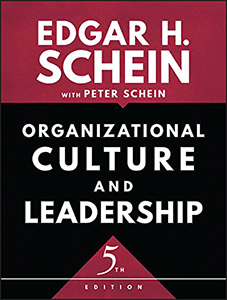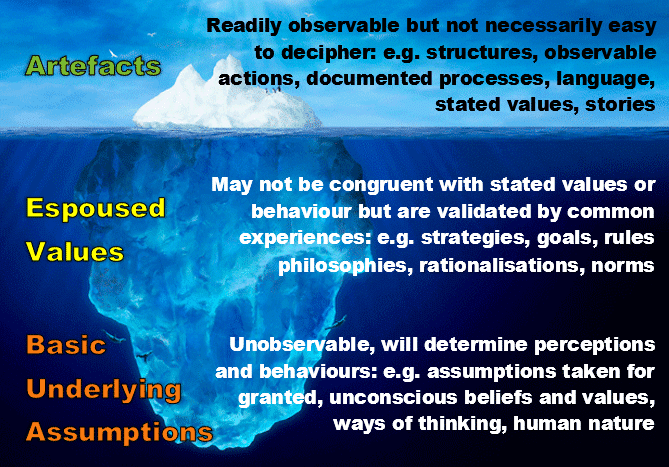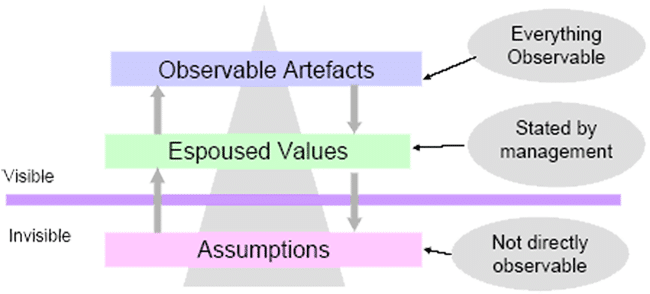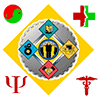
The Nuclear Industry Culture Map
Culture
 Evaluating the safety culture of a particular organisation poses some challenges. Cultural assumptions, which influence behaviour and, therefore, safety performance, are not always clearly observable. Edgar Schein presents a model of culture that helps in understanding how the concept can be assessed. In Schein’s model, culture is assumed to be a pattern of shared basic assumptions, which are invented, discovered or developed by an organisation as it learns to cope with problems of survival and cohesiveness.
Evaluating the safety culture of a particular organisation poses some challenges. Cultural assumptions, which influence behaviour and, therefore, safety performance, are not always clearly observable. Edgar Schein presents a model of culture that helps in understanding how the concept can be assessed. In Schein’s model, culture is assumed to be a pattern of shared basic assumptions, which are invented, discovered or developed by an organisation as it learns to cope with problems of survival and cohesiveness.
 According to Schein’s three-level model, an organisation’s safety culture can be assessed by evaluating the organisation’s artefacts, claimed values, and basic assumptions. On the first level of the model are the organisation’s artefacts. Artefacts are the visible signs and behaviours of the organisation, such as its written mission, vision, and policy statements. The second level consists of the organisation’s claimed or espoused values. Examples of claimed values might include mottos such as, “safety first” or “maintaining a blame-free work environment.” The third level is comprised of the basic assumptions of the individuals within the organisation. Basic assumptions are the beliefs and attitudes that individuals bring into the organisation or that are developed as a result of experience within the organisation. Examples of basic assumptions may include, “safety can always be improved” or “everyone can contribute to safety.” The organisation’s basic assumptions regarding safety culture are less tangible than the artefacts and claimed values. They are often taken for granted within the organisation that shares the culture.
According to Schein’s three-level model, an organisation’s safety culture can be assessed by evaluating the organisation’s artefacts, claimed values, and basic assumptions. On the first level of the model are the organisation’s artefacts. Artefacts are the visible signs and behaviours of the organisation, such as its written mission, vision, and policy statements. The second level consists of the organisation’s claimed or espoused values. Examples of claimed values might include mottos such as, “safety first” or “maintaining a blame-free work environment.” The third level is comprised of the basic assumptions of the individuals within the organisation. Basic assumptions are the beliefs and attitudes that individuals bring into the organisation or that are developed as a result of experience within the organisation. Examples of basic assumptions may include, “safety can always be improved” or “everyone can contribute to safety.” The organisation’s basic assumptions regarding safety culture are less tangible than the artefacts and claimed values. They are often taken for granted within the organisation that shares the culture.
Artefacts, claimed values, and basic assumptions are evaluated to identify the presence or absence of the characteristics that have been found to be important for the existence of a positive safety culture. These characteristics include:
- Safety is a clearly recognised value in the organisation.
- Accountability for safety in the organisation is clear.
- Safety is integrated into all activities in the organisation.
- A safety leadership process exists in the organisation.
- Safety culture is learning driven in the organisation.
Schien has indicated that “attitudes” have been identified to evaluate the extent to which the organisation is able to, or likely to be able to attain these objectives. This methodology was originally developed with the support of the U.S. Nuclear Regulatory Commission to assess the influence of organisation and management on safety performance.
The methodology entails collecting a variety of information that is largely based upon the perceptions of the individuals in an organisation.
Perceptions are often reality when it comes to influencing behaviour and understanding basic assumptions. Therefore, the data collected regarding individuals’ perceptions are critical to this type of assessment.
Transformational Safety® has been very deliberate in selecting Edgar Schein’s Cultural Map as the underlying construct for delivering the Integrated Safety Culture Assessment to Customers. We have done so as the Model is one of the few that takes a special interest in the artefacts of culture and specifically acknowledges the impact of leadership. It is the ideal cultural framework to compliment the developmental approach adopted within the philosophy of The Transformational Safety Improvement System. Click Here to download a sample Report incororporating the Nuclear Industry Cultural Map.

“Most organizations operate in failure states and that just remains invisible because bad stuff is not happening. We might call that the ‘normalization of deviance’ and, make no mistake, it will kill.”

Ricky, Atlanta
![]()
“I was fortunate to attend Transformational Safety’s Anatomies of Disaster Program. This was amongst the most powerful two days I have ever spent in a room. From the outset David Broadbent set the scene by dedicating the program to the late Rick Rescorla – the man who is credited with saving over 2700 lives on 9/11. Throughout the two days David would often respectively reflect and remember those who had died, or been injured, in the disasters we explored. He would say, and I will never forget, “…we must always remember those that lost their lives lift us up into the light of understanding”. I learnt so much. HRO, Resilience Engineering, Critical Incident Stress Management (CISM) and more. Those of us who were there are still talking about it…… Thankyou David


